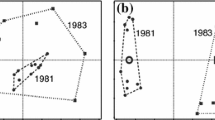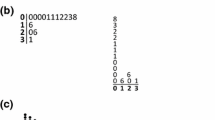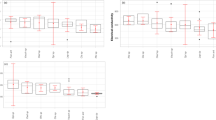Abstract
Two simulated coenoclines and a real data set were differently recoded with respect to the Braun-Blanquet coding (including presence/absence) and analysed through the most common multidimensional scaling methods. This way, we aim at contributing to the debate concerning the nature of the Braun-Blanquet coding and the consequent multidimensional scaling methods to be used. Procrustes, Pearson, and Spearman correlation matrices were computed to compare the resulting sets of coordinates and synthesized through their Principal Component Analyses (PCA). In general, both Procrustes and Pearson correlations showed high coherence of the obtained results, whereas Spearman correlation values were much lower. This proves that the main sources of variation are similarly identified by most of used methods/transformations, whereas less agreement results on the continuous variations along the detected gradients. The conclusion is that Correspondence Analysis on presence/absence data seems the most appropriate method to use. Indeed, presence/absence data are not affected by species cover estimation error and Simple Correspondence Analysis performs really well with this coding. As alternative, Multiple Correlation Analysis provides interesting information on the species distribution while showing a pattern of relevés very similar to that issued by PCA.
Article PDF
Similar content being viewed by others
Avoid common mistakes on your manuscript.
Abbreviations
- BBc:
-
Braun-Blanquet coding
- CA:
-
Correspondence Analysis
- DCA:
-
Detrended Correspondence Analysis
- GPA:
-
Generalized Procrustes Analysis
- MCA:
-
Multiple Correlation Analysis
- MDS:
-
nonmetric MultiDimensional Scaling
- PCA:
-
Principal Component Analysis
References
Abdi, H. 2007. Singular value decomposition (SVD) and generalized singular value decomposition (GSVD). In: N. Salkind (ed.), Encyclopedia of Measurement and Statistics. Sage, Thousand Oaks, CA. pp. 940–945.
Benzécri, J.-P. 1982. L’analyse des données. Dunod, Paris.
Bräuer, H. 1982. Koordinaten-Schweinerei. Münchner Mediziner Wochenschrift 124. quoted in ROeS Nachristen, Biometrische Gesellschaft Region Oesterreich-Schweiz, 15:15.
Braun-Blanquet, J. 1932. Plant Sociology: The Study of Plant Communities. McGraw-Hill, New York. English translation of Pflanzensoziologie by G.D. Fuller and H.S. Conard.
Camiz, S. 1991. Reflections on spaces and relationships in ecological data analysis: effects, problems, and possible solutions. Coenoses 6:3–13.
Camiz, S. 1993. Scopi e finalità dell’analisi della vegetazione e relativi schemi di rilevazione campionaria. In: S. Zani (ed.): Metodi statistici per le analisi territoriali, Studi urbani e regionali. Franco Angeli, Milano. pp. 301–322.
Camiz, S. 1994. A procedure for structuring vegetation tables. Abstracta Botanica 18:57–70.
Camiz, S. 2002. Contributions, à partir d’exemples d’application, à la méthodologie en analyse des données. Chap. 4 — Les données de végétation. Ph.D. thesis, Université Paris IX Dauphine.
Camiz, S. 2005. The Guttman effect: its interpretation and a new redressing method. Data Analysis Bulletin 5:7–34.
Camiz, S. and J.-J. Denimal. 2011. Procrustes analysis and stock markets. Case Studies in Business, Industry and Government Statistics 4:93–100.
Carnevale, N. and P. Torres. 1990. The relevance of physical factors on species distributions in inland salt marshes (Argentina). Coenoses 5:113–120.
Carnevale, N., P. Torres, S. Boccanelli and J.P. Lewis. 1987. Halophilous communities and species distributions along environmental gradients in southeastern Santa Fe Province, Argentina. Coenoses 2:49–60.
Chytrý, M. et al.. 2016. ‘European Vegetation Archive (EVA): an integrated database of European vegetation plots. Appl. Veg. Sci. 19:173–180.
Diday, E. and J.-C. Simon. 1976. Clustering analysis. In: K. Fu (ed.), Digital Pattern Recognition. Springer, Berlin. pp. 47–94.
Dixon, P. 2003. VEGAN, a Package of R functions for community ecology. J. Veg. Sci. 14:927–930.
Eckart, C. and G. Young. 1936. The approximation of one matrix by another of lower rank. Psychometrika 1:211–218.
Frontier, S. 1976. Étude de la décroissance des valeurs propres dans une analyse en composantes principales: Comparaison avec le modèle du bâton brisé. J. Exp. Mar. Biol. Ecol. 25:67–75.
Gauch, H.G. 1982. Noise reduction by eigenvector ordinations. Ecology 63:1643–1649.
Goodall, D.W. and R. Johnson. 1982. Non-linear ordination in several dimensions. Vegetatio 48:197–208.
Goodman, L.A. and W.H. Kruskal. 1954. Measures of association for cross classifications. J. Amer. Stat. Assoc. 49:732–764.
Gower, J.C. 1975. Generalized procrustes analysis. Psychometrika 40:33–51.
Gower, J.C. and G.B. Dijksterhuis. 2004. Procrustes Problems. Oxford University Press, Oxford.
Greenacre, M. 2007. Correspondence Analysis in Practice. 2nd ed. Chapman and Hall/CRC, London.
Guttman, L. 1953. A note on Sir Cyril Burt’s factorial analysis of qualitative data. Brit. J. Stat. Psychol. 6:21–24.
Hill, M.O. and H.G. Gauch. 1980. Detrended correspondence analysis: an improved ordination technique. Vegetatio 42:47–58.
Husson, F., S. Lê, and J. Pagès. 2017. Exploratory Multivariate Analysis by Example Using R. CRC Press, Boca Raton, FL..
Ihm, P. and H. van Groenewoud. 1975. A multivariate ordering of vegetation data based on Gaussian type gradient response curves. J. Ecol. 63:767–777.
Ihm, P. and H. van Groenewoud. 1984. Correspondence analyses and Gaussian ordination. In: J.M. Chambers, J. Gordesch, A. Klas, L. Lebart, and P.P. Sint (eds.), Compstat Lectures. Physica-Verlag, Vienna. pp. 5–60.
Johnson, R.W. and D.W. Goodall. 1980. A maximum likelihood approach to non-linear ordination. Vegetatio 41:133–142.
Kendall, M.G. 1938. A new measure of rank correlation. Biometrika 30:81–89.
Kenkel, N.C. and L. Orlóci. 1986, Applying metric and nonmetric multidimensional scaling to ecological studies: some new results. Ecology 67:919–928.
Kruskal, J.B. 1964a. Multidimensional scaling by optimizing goodness of fit to a nonmetric hypothesis. Psychometrika 29:1–27.
Kruskal, J.B. 1964b Nonmetric multidimensional scaling: a numerical method. Psychometrika 29:115–129.
Kruskal, J.B. and F. Carmone. 1971. How to Use MD-SCAL (Version 5M): And Other Useful Information. Technical report, Bell Laboratories.
Lebart, L., A. Morineau, and K.M. Warwick. 1984. Multivariate Descriptive Statistical Analysis; Correspondence Analysis and Related Techniques for Large Matrices. Wiley, New York.
Lebart L., M. Piron, and A. Morineau. 2006. Statistique exploratoire multidimensionnelle: visualisation et inférences en fouilles de données. Dunod, Paris.
Legendre, P. and L.F.J. Legendre. 2012. Numerical Ecology. 3rd ed. Elsevier, Amsterdam.
Lisboa, F.J.G., P.R. Peres-Neto, G.M. Chaer, E. Da Conceio Jesus, R. J. Mitchell, S.J. Chapman, and R.L.L. Berbara. 2014. Much beyond Mantel: bringing Procrustes association metric to the plant and soil ecologist’s toolbox. PLoS ONE 9(6):e101238
Minchin, P.R. 1987. Simulation of multidimensional community patterns: towards a comprehensive model. Vegetatio 71:145–156.
Noy-Meir, I.. 1971. Multivariate analysis of the semi-arid vegetation in Southeastern Australia: nodal ordination by component analysis. Proc. Ecol. Soc. Aust. 6:159–193.
O’Hara, R.B. and D.J. Kotze. 2010. Do not log-transform count data. Meth. Ecol. Evol. 1:118–122.
Oksanen, J. et al. 2017. Vegan: Community Ecology Package. R-package version 2.4–5. Technical report, URL http://CRAN.R-project.org/package=vegan.
Orlóci, L. 1978. Multivariate Analysis in Vegetation Research. 2nd ed. Junk, The Hague.
Pillar, V.D. 2013. How accurate and powerful are randomization tests in multivariate analysis of variance? Community Ecol. 14: 153–163.
Podani, J. 1997. A measure of discordance for partially ranked data when presence/absence is also meaningful. Coenoses 12:127–130.
Podani, J. 2001. SYN-TAX 2000. Computer Programs for Data Analysis in Ecology and Systematics. User’s Manual. Scientia, Budapest.
Podani, J. 2005. Multivariate exploratory analysis of ordinal data in ecology: pitfalls, problems and solutions. J. Veg. Sci. 16:497–510.
Podani, J. 2006. Braun-Blanquet’s legacy and data analysis in vegetation science. J. Veg. Sci. 17:113–117.
R Core Team. 2015. A Language and Environment for Statistical Computing. Vienna: R Foundation for Statistical Computing.
Ricotta, C. and G. Avena. 2006. On the evaluation of ordinal data with conventional multivariate procedures. J. Veg. Sci. 17:839–842.
Romane, F. 1972. Applications à la phytoécologie de quelques méthodes d’analyse multivariable. Ph.D. thesis, Université des Sciences et Techniques du Languedoc, Montpellier.
Tukey, J.W. 1977. Exploratory Data Analysis. Addison-Wesley, Reading, MA.
van der Maarel, E. 1966. Over Vegetatiestructuren, Relaties en Systemen, in het Bijzonder in de Duingraslanden van Voorne. Ph.D. thesis, Utrecht Universitaet, Utrecht.
van der Maarel, E. 1979. Transformation of cover-abundance values in phytosociology and its effects on community similarity. Vegetatio 39:97–114.
White, G.C. and R.E. Bennetts. 1996, Analysis of frequency count data using the negative binomial distribution. Ecology 77:2549–2557.
Wilson, J.B. 2012. Species presence/absence sometimes represents a plant community as well as species abundances do, or better. J. Veg. Sci. 23:1013–1023.
Acknowledgements
For this work, Camiz and Pillar were supported by the Sapienza Università di Roma and Universidade Federal do Rio Grande do Sul grants for bilateral relations. Camiz was also granted by Sapienza’s agreement with Argentina and by the Special Visiting Researcher Fellowship of Brazilian CNPq, under the Brazilian Scientific Mobility Program “Ciências sem Fronteiras”, Process #: 314443/2014-2.
Author information
Authors and Affiliations
Corresponding author
Electronic supplementary material
Rights and permissions
This article is distributed under the terms of the Creative Commons Attribution 4.0 International License (http://creativecommons.org/licenses/by/4.0/), which permits unrestricted use, distribution, and reproduction in any medium, provided you give appropriate credit to the original author(s) and the source, provide a link to the Creative Commons license, and indicate if changes were made.
About this article
Cite this article
Camiz, S., Torres, P. & Pillar, V.D. Recoding and multidimensional analyses of vegetation data: a comparison. COMMUNITY ECOLOGY 18, 260–279 (2017). https://doi.org/10.1556/168.2017.18.3.5
Received:
Revised:
Accepted:
Published:
Issue Date:
DOI: https://doi.org/10.1556/168.2017.18.3.5




